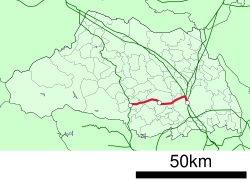Kawagoe Line
| Kawagoe Line | |||
|---|---|---|---|
 Kawagoe Line 209-3000 series EMU at Komagawa Station | |||
| Overview | |||
| Owner | JR East | ||
| Locale | Saitama Prefecture | ||
| Termini | |||
| Stations | 11 | ||
| Service | |||
| Type | Heavy rail | ||
| Depot(s) | Kawagoe | ||
| History | |||
| Opened | 1940 | ||
| Technical | |||
| Line length | 30.6 km (19.0 mi) | ||
| Track gauge | 1067 | ||
| |||
The Kawagoe Line (川越線, Kawagoe-sen) is a railway line operated by the East Japan Railway Company (JR East), which connects the cities of Saitama, Kawagoe, and Hidaka in Saitama Prefecture, Japan. The main transfer stations on the line are Saitama, Kawagoe, and Komagawa.
Services
The section between Kawagoe and Ōmiya operates as an extension of the Saikyō Line from central Tokyo, with most trains traveling through to/from Ōsaki and on to/from Shin-Kiba via the Rinkai Line. On the section between Kawagoe and Komagawa, about half of all trains travel through to/from Hachiōji via the Hachikō Line.
Except for a few rush-hour trains that start and terminate at Minami-Furuya, all eastbound trains from Komagawa and westbound trains from Ōmiya terminate at Kawagoe. Passengers wishing to travel beyond Kawagoe must change trains there.
Station list
- All stations are located in Saitama Prefecture.
- Passengers bound for Ōmiya or Komagawa must change trains at Kawagoe. However, during early mornings and evenings, some trains leaving Kawagoe depot provide service from Minami-Furuya to Komagawa.
- All rapid or commuter rapid trains to/from the Saikyō Line stop at every station on the Kawagoe Line.
- Trains can pass each other at stations marked "∥", "∨", and "◇"; they cannot pass at stations marked "|".
| Station | Japanese | Distance (km) | Transfers | Location | ||||
|---|---|---|---|---|---|---|---|---|
| Between stations |
Total | |||||||
| Through services to/from Shin-Kiba on the Rinkai Line via the Saikyō Line | ||||||||
| Saitama | 大宮 | - | 0.0 | from Ōsaki 36.9 |
Saikyō Line (through service), Tōhoku Shinkansen, Yamagata Shinkansen, Akita Shinkansen, Jōetsu Shinkansen, Nagano Shinkansen, Keihin-Tōhoku Line, Tōhoku Main Line (Utsunomiya Line), Takasaki Line, Shōnan-Shinjuku Line Tōbu Noda Line Ina Line (New Shuttle) |
∥ | Ōmiya-ku | Saitama |
| Saitama | 日進 | 3.7 | 3.7 | 40.6 | ∨ | Kita-ku | ||
| Nishi-Ōmiya | 西大宮 | 2.6 | 6.3 | 43.2 | ◇ | Nishi-ku | ||
| Sashiōgi | 指扇 | 1.4 | 7.7 | 44.6 | ◇ | |||
| Minami-Furuya | 南古谷 | 4.7 | 12.4 | 49.3 | ◇ | Kawagoe | ||
| Kawagoe | 川越 | 3.7 | 16.1 | 53.0 | Tōbu Tōjō Line Seibu Shinjuku Line (Hon-Kawagoe) |
◇ | ||
| from Hachiōji 45.6 | ||||||||
| Nishi-Kawagoe | 西川越 | 2.6 | 18.7 | 43.0 | | | |||
| Matoba | 的場 | 2.2 | 20.9 | 40.8 | ◇ | |||
| Kasahata | 笠幡 | 2.9 | 23.8 | 37.9 | | | |||
| Musashi-Takahagi | 武蔵高萩 | 3.2 | 27.0 | 34.7 | ◇ | Hidaka | ||
| Komagawa | 高麗川 | 3.6 | 30.6 | 31.1 | Hachikō Line (through service) | ◇ | ||
| Through services to/from Hachiōji on the Hachikō Line | ||||||||
Rolling stock

The current EMU fleet used on Kawagoe Line services is based at Kawagoe Depot (close to Minami-Furuya Station).[1]
- 205 series 10-car EMUs x 32 (Kawagoe Line/Saikyō Line/TWR Rinkai Line services)
- TWR 70-000 series 10-car EMUs (Kawagoe Line/Saikyō Line/TWR Rinkai Line services)
- 205-3000 series 4-car EMUs x 5 (Kawagoe Line/Hachikō Line services)
- 209-3000 series 4-car EMUs x 4 (Kawagoe Line/Hachikō Line services)
- 209-3100 series 4-car EMUs x 2 (Kawagoe Line/Hachikō Line services)
31 new 10-car E233 series EMUs are scheduled to be introduced on Saikyō Line, Kawagoe Line, and Rinkai Line services between Kawagoe and Shin-Kiba from fiscal 2013, displacing the fleet of 205 series EMUs.[2]
Rolling stock previously used

- 9600 class steam locomotives (until September 1969)
- KiHa 07 diesel cars (from 1955)
- KiHa 15 DMUs
- KiHa 20 DMUs
- KiHa 35 DMUs (1964 – September 1985)
- 103-3000 series EMUs (until October 2005)
- 103-3500 series EMUs (until March 2005)
History
Line opening
A line linking Ōmiya with Kawagoe and continuing to the Hachikō Line at Komagawa was first proposed in March 1920. Construction work started in September 1935, with the line opening on 22 July 1940.[3]
Switch to diesel
Services were initially steam hauled, but diesel multiple unit trains were introduced from 1 June 1950. The final steam-hauled passenger train ran on 30 September 1969.[3]
Electrification
The line was electrified (1,500 V DC) from 30 September 1985, and through running commenced to and from the Saikyō Line, which opened at the same time. The tracks were doubled between Ōmiya to Nisshin, and a new EMU depot was opened close to Minami-Furuya Station. A special "Kawagoe Line Diesel Sayonara" train ran on the line on 3 November 1985.[3]
Hachikō Line through services
Through services between Kawagoe and Hachiōji on the Hachikō Line began on 16 March 1996 following the electrification of the southern section of the Hachikō Line between Komagawa and Hachiōji.[3]
References
- ^ JR電車編成表 2012冬. Japan: JRR. October 2011. p. 66-67. ISBN 978-4-330-25611-5.
{{cite book}}: Unknown parameter|trans_title=ignored (|trans-title=suggested) (help) - ^ "秋田新幹線用車両と埼京線・横浜線用車両の新造について" (PDF) (in Japanese). JR East. 10 April 2012. Retrieved 10 April 2012.
{{cite web}}: Unknown parameter|trans_title=ignored (|trans-title=suggested) (help) - ^ a b c d 歴史でめぐる鉄道全路線 国鉄・JR NO.45 埼京線・八高線・川越線・武蔵野線・京葉線. Japan: Asahi Shimbun Publications Inc. June 2010. ISBN [[Special:BookSources/4910222710600 |4910222710600 [[Category:Articles with invalid ISBNs]]]].
{{cite book}}: Check|isbn=value: invalid character (help); Unknown parameter|trans_title=ignored (|trans-title=suggested) (help)
External links
- Stations of the Kawagoe Line (JR East) Template:Ja icon

